Ever feel like your content is invisible even after hours of work?
You’re not alone — many teams treat SEO and content marketing as separate strategies, but their real power comes from working together. SEO makes your work discoverable while content marketing keeps visitors engaged and moving toward conversion.
When these two strategies align, you create a repeatable process that builds visibility, drives organic traffic and delivers measurable growth.
This guide explains the relationship between SEO and content marketing, how to integrate them effectively and the metrics that prove ROI.
Key takeaways
- Mutual growth: SEO and content marketing work together to boost visibility and engagement.
- Core principles: Target keyword planning, link building, creating engaging content and user experience optimization strengthen both strategies.
- Adaptability: Staying current with trends and algorithm updates keeps your content competitive and effective over time.
What are SEO and content marketing?
Before we describe the relationship between content marketing and SEO, it helps to first clarify what each one is.
Search Engine Optimization (SEO)
This is the practice of making your website easy for Google and other search engines to find, understand and rank.
SEO includes both technical and non-technical work, such as:
- Identifying keywords
- Defining your audience
- Page speed and performance
- Mobile optimization
- Site architecture and crawlability
- Metadata like titles, descriptions and image alt text
- Structured data and schema
Content marketing
Creating and sharing content your audience actually wants. It’s less about algorithms and more about people.
Common types of content marketing include:
- Blog posts and guides
- Videos and podcasts
- Infographics
- Social content
- Email campaigns
In short, SEO helps people find you — content marketing gives them a reason to stay.
One focuses on visibility, the other on value.
SEO and content marketing comparison at a glance
| SEO focus | Content marketing focus |
|---|---|
| Technical optimization | Storytelling and messaging |
| Keywords and metadata | Blog posts, videos and guides, etc. |
| Crawlability | Distribution and promotion |
| Ranking signals | Lead nurturing and trust-building |
🎬 Learn what Slickplan can do!
We filmed a short video to show you exactly how to use Slickplan
Why SEO and content marketing need each other
It’s SEO and content marketing — not content marketing vs SEO. One without the other doesn’t work.
SEO makes your work accessible, ensuring your content is discoverable and visible. Content marketing delivers thoughtful, valuable content that satisfies search intent and attracts your target audience.
You can have the fastest, most technically sound SEO site in the world, but without strong content, it still won’t rank well. On the flip side, even the best articles won’t drive traffic without proper SEO.
They come together through smart SEO content planning.
How SEO fuels content discovery
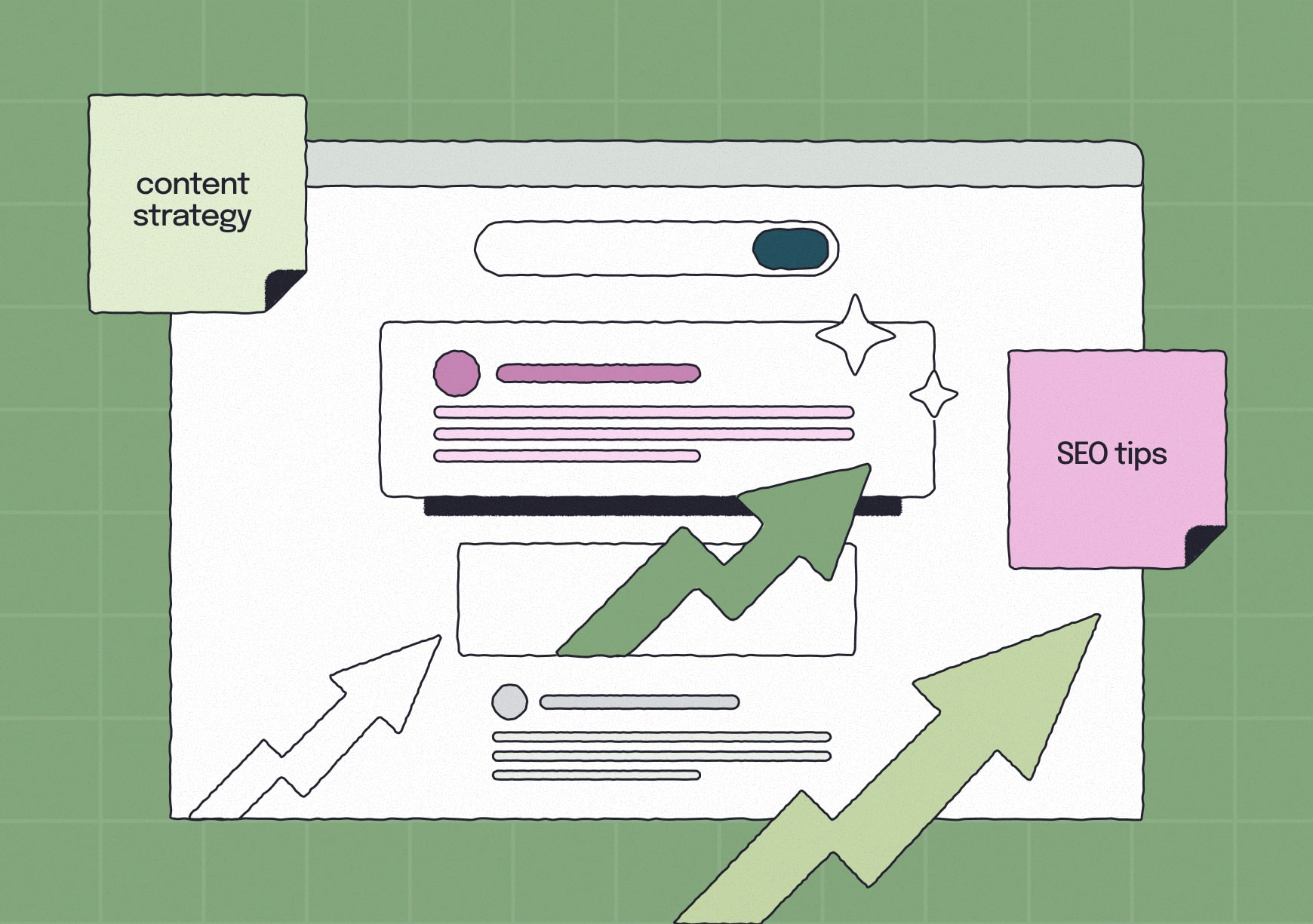
SEO drives relevant traffic, helping your content reach the right audience. For example:
- Keyword research helps shape what to write
- Metadata improves click-throughs on search engines
- Schema markup makes content eligible to appear as rich results (the results beyond the link, like carousels, images, snippets, etc.)
Ranking higher matters — 54.4% of all clicks go to the top three search results.
Without SEO, even your best content can get buried.
How do SEO and content marketing work together?
SEO ensures discoverability, while content marketing ensures relevance and engagement. In other words, SEO brings people in and content marketing keeps them around — one drives visibility, the other delivers value.
How content powers SEO performance
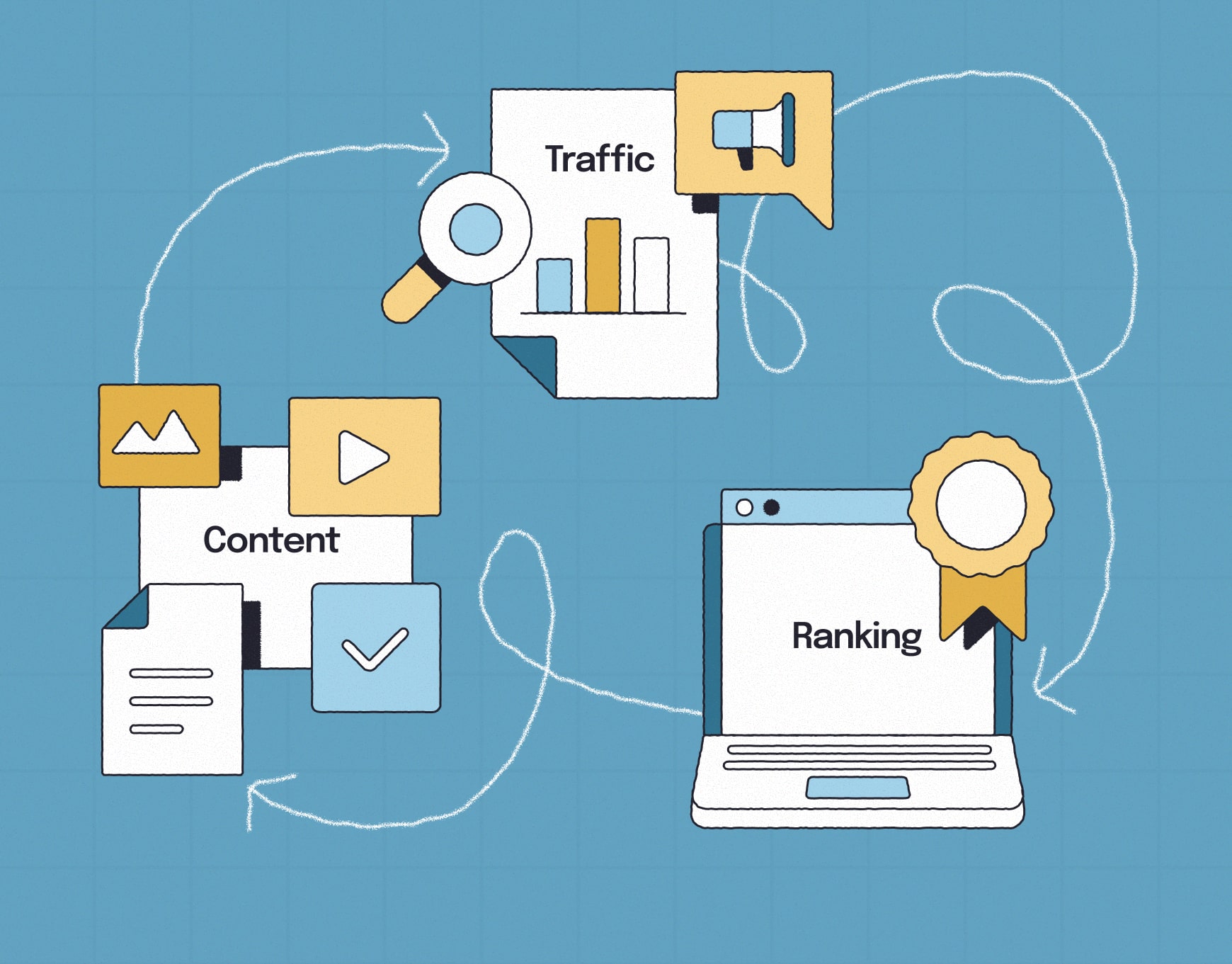
Creating valuable content keeps visitors on your site longer, drives engagement and earns backlinks. These signals feed directly into better rankings. High-value resources act like magnets that attract links and shares, strengthening SEO even more.
Think of website content planning as a loop: SEO drives people to your content, and great content strengthens SEO in return.
SEO + content marketing: A case study
Here at Slickplan, we’ve seen firsthand how SEO and content marketing work together.
We updated a set of underperforming blog posts to create more relevant content that would drive more traffic by matching search intent and generating better organic search results.
Within weeks of relaunching, we saw dramatic improvements. Proof that aligning SEO with content creation delivers real results.

How to build an integrated SEO content marketing strategy
Combining content marketing and SEO shouldn’t feel like guesswork. It’s the exact opposite, in fact; a repeatable process that moves from research to execution to refinement to form a cohesive SEO content strategy.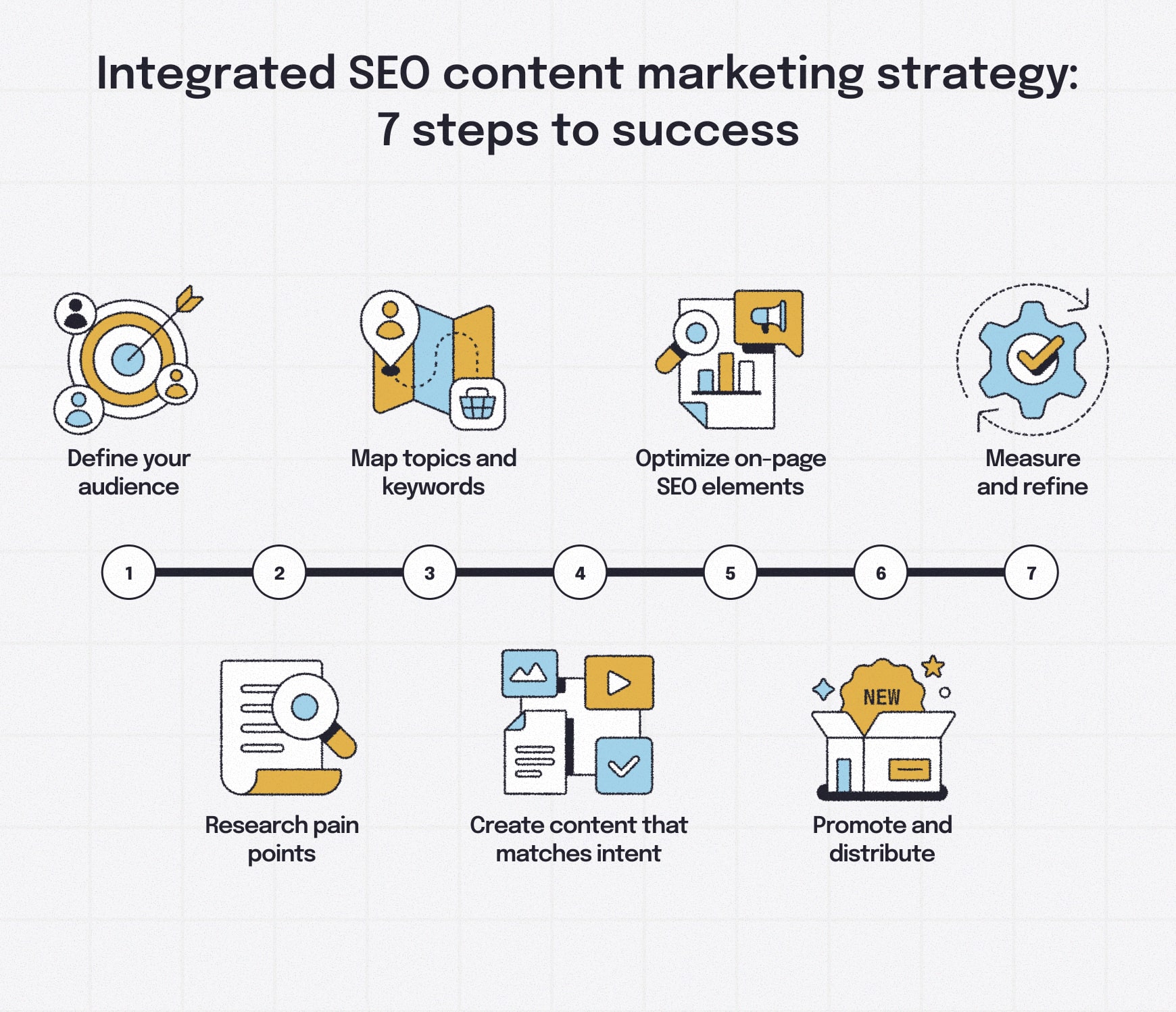
Here’s how to do it step by step:
1. Define your audience
Having a clearly defined audience to tailor your content to is vital for creating material that truly connects. So, before you start generating keyword ideas and pondering content formats, identify who you’re going to be speaking to first. On a basic level, ask yourself questions like:
- What’s their industry and role?
- What are their key demographics?
- What problems do they need solved?
- Where do they go for answers: search engines, forums or social media platforms?
The clearer the picture you have of your target audience or personas, the more precisely you can tailor your content to match their search intent and align it with the user’s search query. Tools like Google Analytics and Semrush are a big help here.
👉 Why it matters: Audience clarity makes every later step more focused, ensuring you create content that speaks to real needs.
2. Research pain points
Combine audience insights with thorough keyword research. Tools like Google Keyword Planner and Ahrefs help uncover search volume, validate demand and provide keyword analysis to understand the queries that lead people to answers.
👉 Why it matters: Research ensures you’re solving problems people care about and targeting the specific keywords they use to find solutions.
3. Map topics and keywords
Group related search queries into topic clusters anchored around main pillar pages. For example, a pillar page on Content Strategy 101 could branch into related subpages like Keyword Research, Content Calendar Planning and Content Distribution.
We do this on our own site: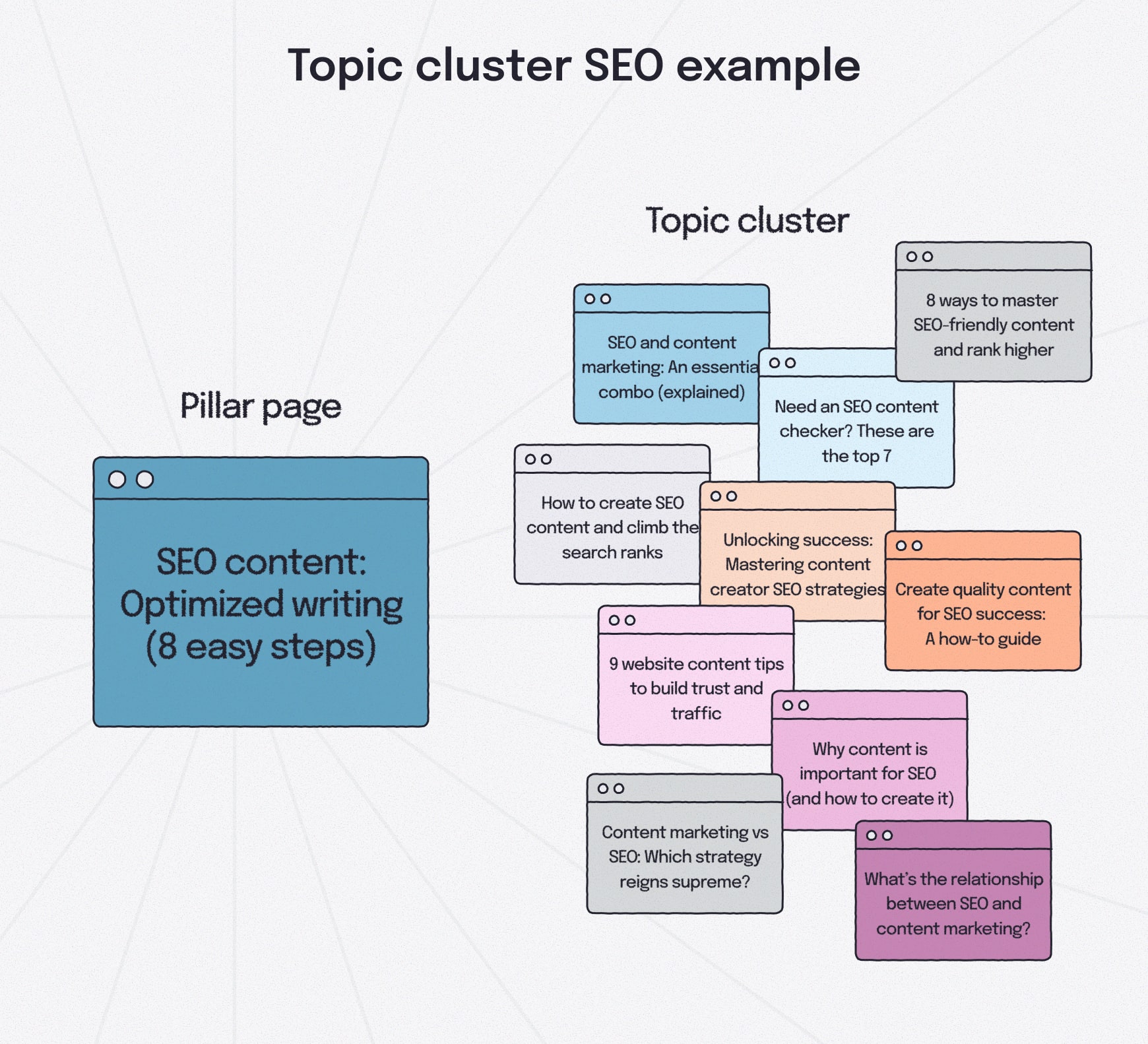
👉 Why it matters: Building topical authority helps you rank across full subject areas rather than single keywords — a core SEO strategy for content marketing.
4. Create content that matches intent
"Search intent" simply means what someone is actually looking for when they search on Google.
Match the types of SEO content you choose to build to the search intent:
- Informational intent → wants to learn → create guides, blogs, explainer videos
- Commercial intent → wants to evaluate options → create comparison pieces, case studies, white papers
- Transactional intent → wants to buy → create product pages, pricing pages, demos
👉 Why it matters: On-page optimization helps search engines understand your content and makes users more likely to click.
6. Promote and distribute
Push content across the channels that are relevant to your audience. Meet them where they are. Look for ways to get eyes on your most important content; a strong piece doesn’t spread itself. All the optimization you’ve done throughout this process also serves as a way of promoting content through SEO.
👉 Why it matters: Distribution of high-quality content extends reach and accelerates backlink acquisition.
7. Measure and refine
Review the performance of your content regularly to see where improvements can be made. Tools like Google Analytics 4, Google Search Console and Screaming Frog show you what’s working and what needs updating. Refresh outdated posts, consolidate thin pages and double down on winners.
👉 Why it matters: Combining SEO efforts and content creation is an ongoing cycle, not a one-time campaign.
On-page, off-page and technical SEO: How they work together
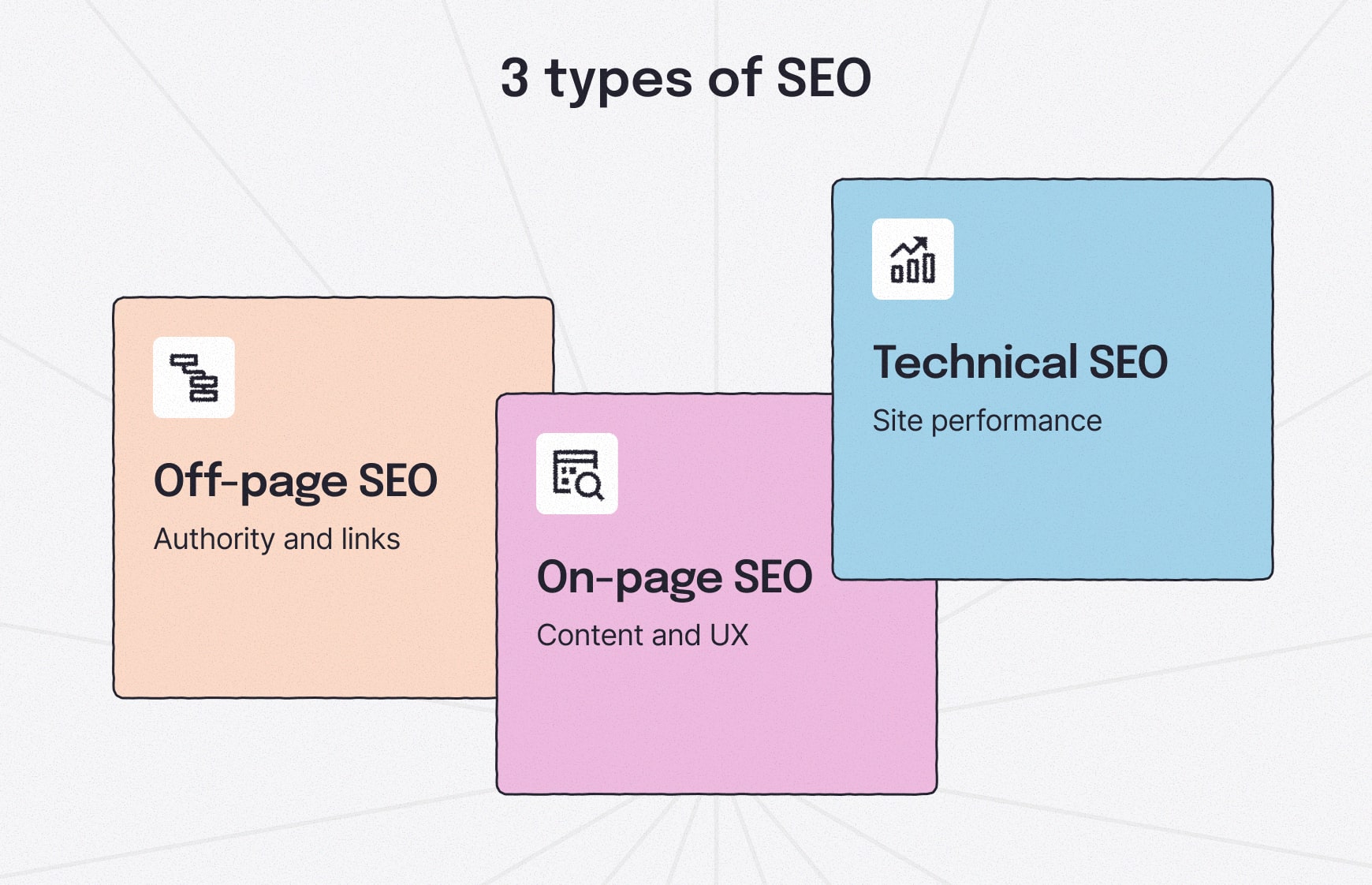
SEO isn’t a single tactic. It’s three interconnected layers that, when aligned with content marketing, make your content discoverable, credible and user-friendly.
Think of it this way:
On-page SEO makes your content relevant, off-page SEO builds authority and technical SEO ensures everything runs smoothly.
Even if your content already ranks, improving each part of this SEO trifecta can help you climb higher in search results.
Core on-page SEO elements to focus on
On-page SEO is everything you do directly on your site to improve visibility and engagement. The key elements include:
- Content quality and keywords: SEO marketing content should match search intent and incorporate relevant terms naturally into titles, headers, and body text. SEO content checkers like Semrush or Ahrefs can guide keyword SEO research and placement.
- HTML elements: Title tags, meta descriptions and image alt text should be clear, descriptive and encourage clicks.
- Internal linking: Logical structures that guide users to related content and help search engines map your site. Internal links connect pillar pages to supporting content and help search engines map relationships across your site.
- Readability & UX: Short paragraphs, scannable headings and clear language keep readers engaged longer.
📌 Slick Tip: Do a content audit to get a deep understanding of your own content, the gaps you need to fill with content marketing and how to build out silos.
Off-page SEO efforts that move the needle
Off-page SEO builds trust and authority through signals that happen outside your own site. In practice, that covers things like:
- Backlinks : High-quality links from authoritative, relevant domains are among the strongest off-page ranking factors. Track them with tools like Moz or Semrush to spot and disavow spammy or harmful links.
- Brand mentions: Even unlinked mentions across blogs, forums or social platforms reinforce authority.
- Social signals: Shares, likes and comments don’t directly affect rankings but amplify reach and can lead to new backlinks.
- Local SEO: Listings in Google Business Profile, Yelp or industry directories improve visibility for local and location-based searches.
💡 Slick Tip: Instead of chasing links, create content worth referencing — guides, tools or templates that naturally attract backlinks and mentions.
Technical SEO — optimize what’s under the hood
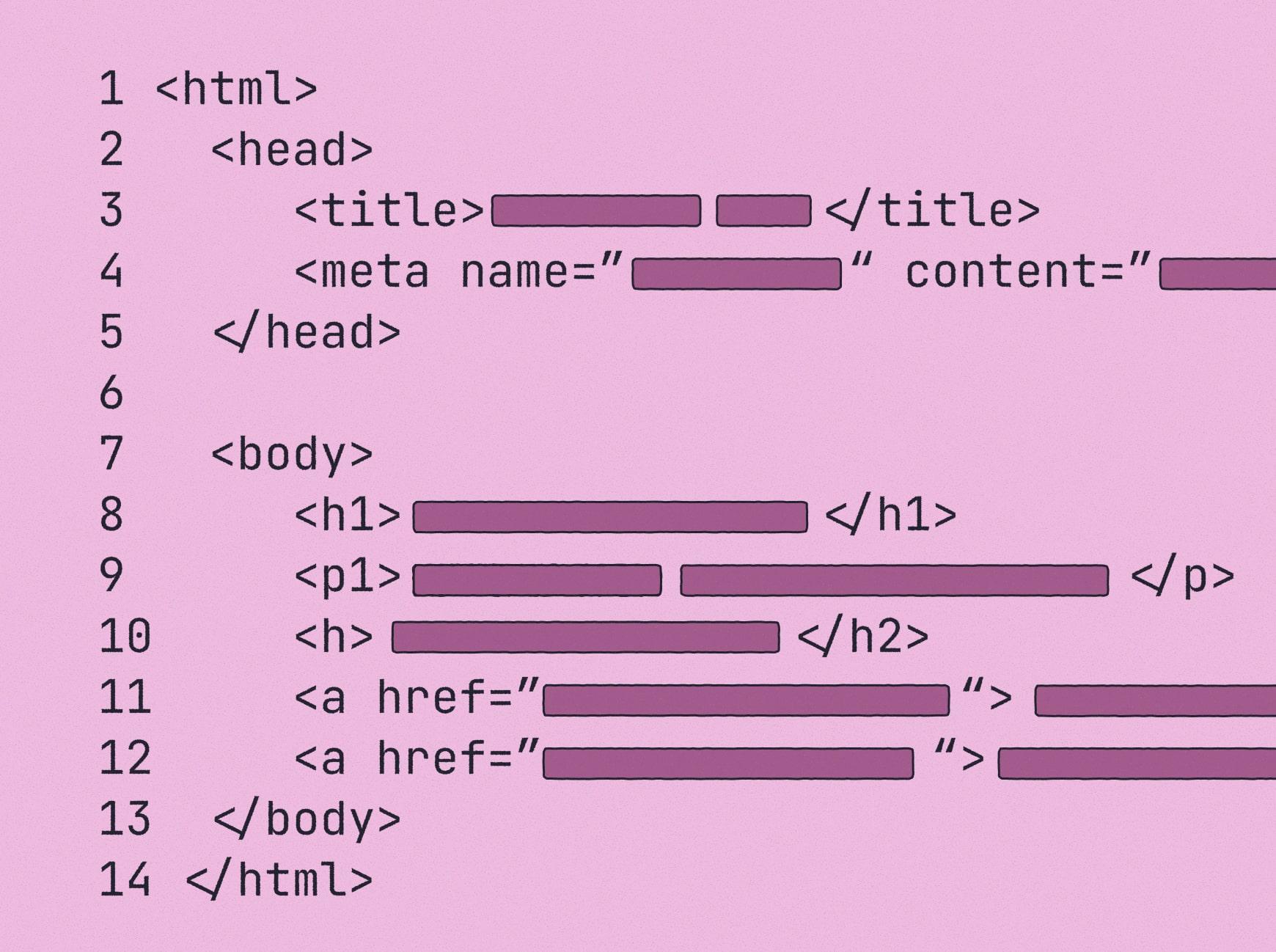
The best content won’t rank if your site isn’t optimized from a technical standpoint. That means optimizing the technical elements that help search engines crawl, index and deliver your pages to the right audience.
- Crawlability and ease of indexing: XML sitemaps list your site’s pages in a way that’s easy for search engines to crawl and index. Make sure to update and submit your XML sitemap as well as confirm your robots.txt file isn’t blocking important pages.
- Site speed and performance (for crawlers): Search engines use load time as a ranking factor; faster sites get prioritized in results. Use tools like PageSpeed Insights or GTmetrix to identify and fix performance bottlenecks. For quick results, basics like compressing images, enabling caching and minimizing scripts can boost performance.
- Core Web Vitals: Optimize for Largest Contentful Paint (LCP), First Input Delay (FID) and Cumulative Layout Shift (CLS) to improve real-world user experience.
- Mobile-first indexing: Google now evaluates your site’s mobile version first, meaning your mobile version must be fully functional and accessible. To put it more clearly, Ahrefs lays it out like this: "If your site’s content is not accessible at all with a mobile device, it will no longer be indexable".
- HTTPS security: SSL certificates protect users and provide a trust signal.
- Structured data (schema): Add structured data and context to help search engines understand your content and make it eligible for rich snippets.
- Canonicalization: Use canonical tags to prevent duplicate content issues and consolidate ranking signals across URLs.
💡 Slick Tip: Learn the content guidelines for SEO and use a tool like Slickplan’s Sitemap Builder to regularly audit your site structure; a clean sitemap makes it easier for crawlers to navigate and ensures no critical page is buried.
Why backlinks still matter
Even with great content and solid technical SEO, you’ll be hard-pressed to reach your full ranking potential without putting some real effort into getting backlinks.
Links from other reputable sites act as votes of confidence, telling search engines your content is top-tier and, more importantly, credible.
High-quality backlinks can:
- Improve domain authority and keyword rankings
- Send referral traffic from trusted sources
- Strengthen your brand and website’s visibility and credibility
But not all links are equal; it’s quality over quantity every time.
Strategies for earning backlinks

- Create link-worthy content
Easier said than done, but in-depth guides, original research or interactive tools will naturally attract citations. Think of content that others want to reference. Backlinko is incredible at this, creating thorough articles on the topics they own, like their guide to link building. -
Guest posting and expert contributions
Writing for reputable industry blogs not only showcases your expertise but also earns you a contextual backlink. - Digital PR and resource outreach
Pitch your content to journalists or site owners with relevant resource pages. For example, if you publish a "Content Calendar Template", reach out to sites curating marketing tools. - Broken link building
Use tools like Ahrefs to find dead links on industry sites, then offer your content as a replacement — a win-win for both parties.
How to avoid common backlink fails
- Skip low-quality sites: Links from spammy domains can actually hurt more than help.
- Don’t over-optimize anchor text: Keep it natural; mix branded and descriptive anchors.
- Avoid link schemes: Buying links or excessive exchanges can trigger penalties.
💡 Slick Tip: Focus on building relationships, not just links. Networking with peers and industry voices often leads to organic linking opportunities over time.
Enhancing user experience for SEO and content marketing

Here’s a very simple truth: search engines reward websites that people actually enjoy using.
That means your SEO strategy can’t stop at rankings; it has to deliver a seamless experience once visitors arrive.
A strong user experience boosts engagement, reduces bounce rates and signals to search engines that your site deserves higher visibility.
Key user experience SEO factors
- Site speed and performance (for people): Slow pages drive users away and hurt rankings. Even a 1-second delay in loading time can spike bounce rates.
- Mobile optimization: With mobile-first indexing, a responsive design isn’t optional; it’s essential.
- Navigation and structure: Clear menus and logical page hierarchies keep users (and crawlers) oriented. Slickplan’s Sitemap Builder helps visualize this and the AI sitemap assistant can work wonders with optimization.
- Accessibility: Alt text, ARIA labels and readable font sizes make content usable for all visitors and improve compliance.
- Content readability: Short paragraphs, clear headings and concise language improve dwell time and comprehension.
Crafting user-centric content
At the end of the day, everything comes back to the reader. UX- and SEO-friendly content answers questions directly, uses the same language your audience does and avoids fluff.
Creating content people flock to is ultimately an exercise in understanding your audience.
If you’re striving for sustainable SEO success and stronger website traffic, being user-focused is your calling card for both. In practice, that might look like:
- A video that walks someone through a process
- A step-by-step guide that solves a problem in plain English
- A case study showing real-world results and lessons learned
- An interactive template or checklist that makes the reader’s job easier
Your content should always answer real questions and solve real problems.
💡 Slicktip: Test your content like a user. Does it load fast? Is it skimmable? Can someone find the answer they came for in under 30 seconds? If not, refine
Measuring the impact: SEO and content marketing metrics to focus on

Without feedback, you’ll never know if you’re improving; that goes for everything you do in life as much as it does for search engine optimization and marketing. Tracking key performance indicators (KPIs) and using analytics tools provides valuable insight into how effective your strategies are, helping you make data-driven decisions to improve content quality and search rankings.
Key SEO and content metrics

A strategy only works if you know it’s working. Measuring the results of your SEO and content marketing shows where you’re winning, where you’re wasting effort, and where to double down. Because let’s face it, without data, you’re just guessing.
- Organic traffic: How many people find your site through search? Analytics tools like Google Analytics or Search Console provide these numbers.
- Click-through rate (CTR): Indicates whether your titles and meta descriptions are compelling enough to earn clicks. Search performance tools like Google Search Console track this.
- Dwell time and bounce rate: Measure how long visitors stay engaged before leaving. Behavior tools such as GA4 or Hotjar reveal these patterns.
- Keyword rankings: Tracks how well you’re moving up for important terms. SEO platforms monitor positions (e.g., Semrush, Ahrefs)
- Conversions and assisted conversions: Show whether readers take key actions such as sign-ups, demos or downloads. Conversion tools like GA4, HubSpot and Salesforce measure these.
- Cost per acquisition (CPA): Calculates how much it costs to generate a lead through organic efforts — often derived from analytics and campaign cost data.
- Lifetime value (LTV): Captures the long-term revenue potential of organic leads. CRM platforms like Salesforce and HubSpot calculate this metric.
Tools snapshot
| What to measure | Tools to use |
|---|---|
| Organic traffic | Google Analytics 4, Search Console |
| Keyword rankings | Semrush, Ahrefs |
| Technical health | Screaming Frog, Sitebulb |
| Engagement signals | GA4, Hotjar |
| Conversions and ROI | GA4, HubSpot, Salesforce |
Content audits and the cycle of refinement
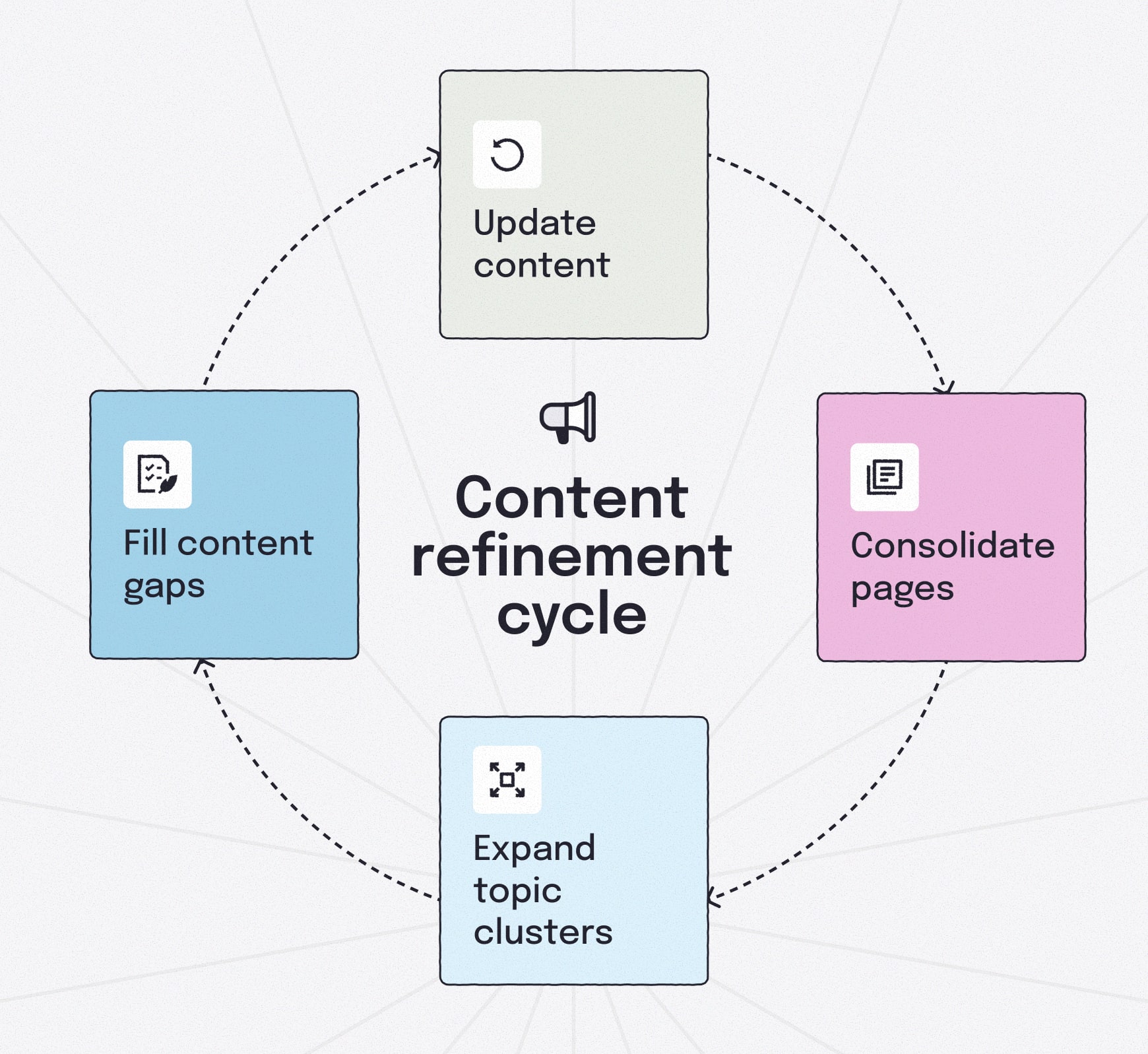
Regularly reviewing existing content keeps your site competitive, your content optimized and your online visibility high. You’ve heard of the ABCs of sales — "Always Be Closing." For content, think ABO: "Always Be Optimizing."
It’s a constant cycle of content refinement.
When reviewing your website, look to these areas:
- Outdated content: Refresh stats, update screenshots, add new insights and make sure you’re tackling relevant keywords.
- Thin or duplicate pages: Consolidate into stronger, single resources where possible.
- Top performers: Expand into full topic clusters with supporting pages to bring more relevant traffic.
- Content gaps: Compare against competitors and other websites to find topics you’re missing or different angles to cover.
Calculating ROI on your SEO and content marketing strategy

We’re not going to break down the costs of putting together and executing your strategy because marketing plans can vary in scope massively depending on your needs, audience and company size. That said, it’s still essential to measure your return on investment (ROI).
Here’s a simple formula for getting your ROI percent:
ROI = ((Value of conversions driven by organic traffic — Cost of content and SEO) ÷ Cost of content and SEO)) x 100
Example: If you spend $5,000 producing and promoting a series of blog posts and those posts generate 20 leads worth $500 each ($10,000 total), your ROI is 100%.
Remember, organic ROI isn’t always immediate; it compounds both with the time that it’s out there and with the amount of quality content for SEO you produce and distribute.
💡 Slick Tip: Don’t only track raw traffic and other metrics that might feel good. Focus on measuring conversion-focused metrics like sign-ups, purchases, demos and various other profitable customer actions. Ranking first for a vanity keyword, for example, means little if it doesn’t generate leads or revenue.
Navigating challenges in the SEO and content marketing landscape

A great strategy goes a long way, but navigating the combination of SEO and content marketing comes with hurdles. Competitors are running similar playbooks, algorithms keep shifting and user expectations never stop evolving. Knowing the challenges up front helps you adapt before they slow you down.
Adapting to algorithm updates

Google alone makes thousands of algorithm updates each year (yes, thousands). Some are small, but major ones can reshape the search landscape overnight. What gets results today may not work tomorrow, so staying current with changes, like the shift from E-A-T (expertise, authoritativeness, trustworthiness) to E-E-A-T (adding experience), ensures your content stays relevant and competitive.
Balancing optimization with authenticity
The technical side of SEO matters, but without original ideas and authenticity, your content won’t rank as high as it could. It’s tempting to chase rankings via optimization, but over-optimized content that lacks a genuine voice or angle rarely performs long-term. The best results come from striking a balance: technically sound SEO paired with content that’s authentic, helpful and written for people first.
Keeping pace with competitors
If you’ve found a content gap, chances are others are working to fill it too. That’s why regular content audits, updating existing pages and experimenting with new formats, like video or interactive tools, are essential for staying ahead.
Responding to changing user behaviors
How people search, and what they expect when they click, keeps evolving. From voice search queries to mobile browsing to accessibility needs, adapting your content, digital marketing and site experience to these shifts is no longer optional.
Trends shaping SEO and content marketing
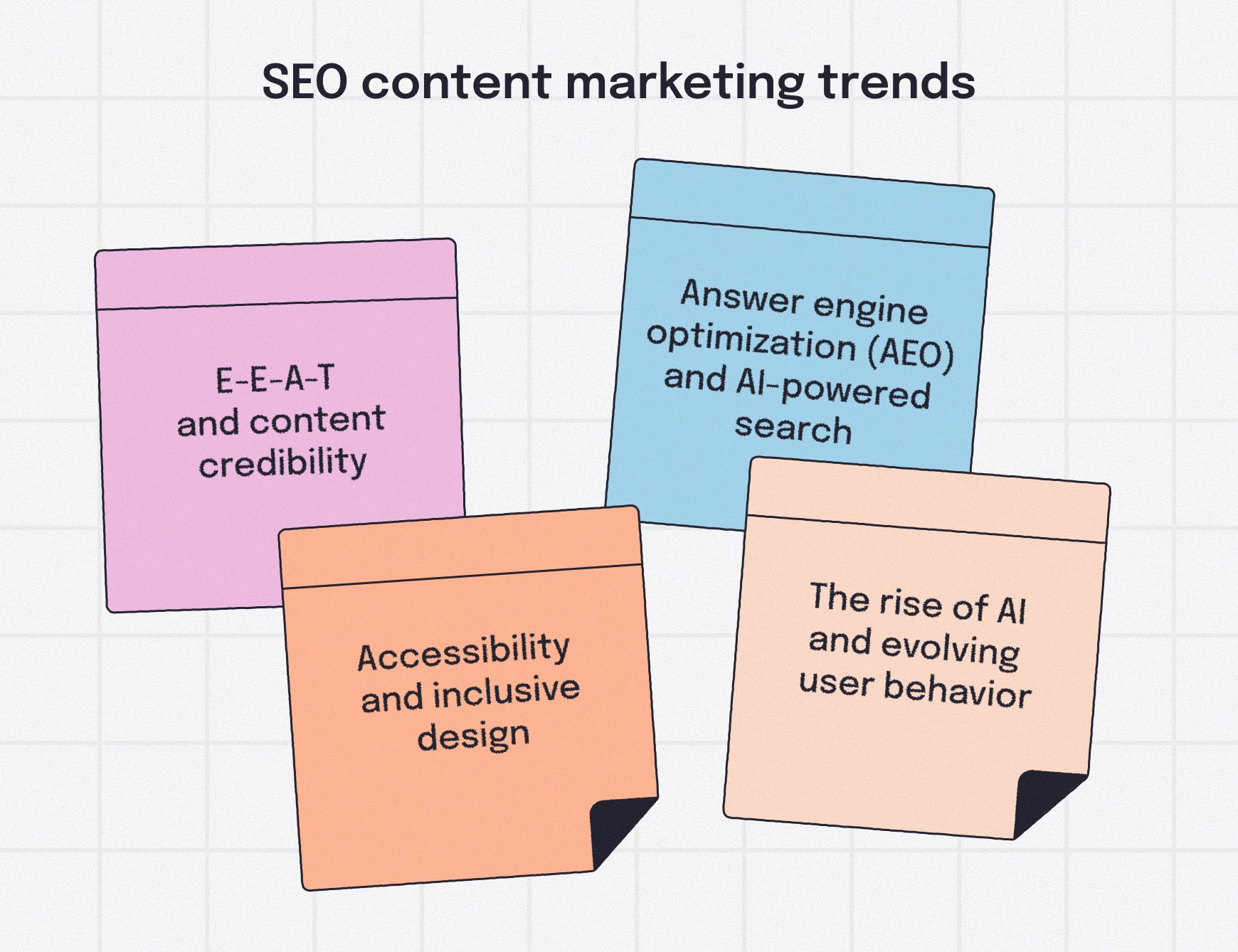
Search and content are never static. The way people find and consume information shifts constantly and so do the signals search engines use to rank content. Staying on top of these trends ensures your strategies remain relevant and effective.
E-E-A-T and content credibility
Google’s quality rater guidelines shifted from E-A-T (Expertise, Authoritativeness, Trustworthiness) to E-E-A-T (adding Experience), for example. That means it’s not enough to write well-optimized articles anymore; content needs to show first-hand knowledge, cite credible sources and make the author’s expertise clear. That means:
- Using bylines with credentials
- Adding case studies, data or examples from your own work (which we’ve done above with our own proof 😉)
- Linking to trusted external references
Answer engine optimization (AEO) and AI-powered search
Search isn’t just ten blue links anymore. Voice assistants, AI overviews and featured snippets now deliver direct answers. Optimizing for this answer-first landscape means:
- Structuring content with clear headings and FAQ sections
- Using schema markup to signal context
- Writing concise answers to common questions
Accessibility and inclusive design
Accessibility is no longer a "nice-to-have"; search engines are increasingly rewarding sites that serve users well. Inclusive design practices like alt text for images, ARIA labels (Accessible Rich Internet Applications), readable font sizes and mobile-friendly layouts improve usability while expanding the reach of your content marketing efforts.
Marketing for SEO now requires a focus on inclusive design principles because making sure content is accessible to all users not only broadens reach but also gets positive signals from search algorithms.
The rise of AI and evolving user behavior
AI tools are changing how content is produced, discovered and consumed. Users are asking longer, conversational queries and expect faster, more relevant results. Marketers who adapt by blending human insight with smart use of AI are bound to stay ahead.
Video search results
Video is already a search priority. YouTube is the second largest search engine and you’ve probably noticed that Google regularly shows video results now. Not only do you want to be thinking about moving into video, but also optimizing that content with video titles, descriptions and transcripts to help your clips rank in both YouTube and Google search.
Content marketing and SEO: The power duo fueling your site’s visibility
Harmonizing the two strategies is what makes both work better; they work hand in hand, influencing and enhancing each other’s effectiveness. As SEO makes the content discoverable, high-quality content improves SEO by engaging visitors, increasing time on-page, generating backlinks and more.
This mutual growth leads to better performance, increased visibility and more targeted traffic from your potential customers or clients.
When it comes to content marketing and SEO, the whole truly is greater than the sum of its parts.
Ready to align your SEO and content strategy?
Plan smarter with Slickplan’s online Content Planner and Sitemap Builder, tools built to help you create, organize and publish content that ranks.
Plan smarter content with Slickplan
A collaborative workspace to handle all your content needs. Plan, gather and create together.
Frequently Asked Questions
What is the importance of content marketing in SEO?
Content marketing is vital for SEO, improving rankings with quality content and optimized keywords. It boosts user engagement, attracts links and amplifies visibility on social media. Addressing user intent and regularly updating content contribute to long-term online success.
How to calculate the ROI of SEO from content marketing?
Calculate ROI with the formula: (Value of conversions driven by organic traffic – Cost of content and SEO) ÷ Cost of content and SEO. For example, if you spend $5,000 and generate $10,000 in leads, your ROI is 100%. Keep in mind that SEO ROI compounds over time as content continues to perform.
What is the relationship between content marketing and SEO?
Content marketing and SEO are integral components of a successful digital strategy; SEO helps bring visitors to your content, while the content itself boosts rankings and drives traffic. Combining them both will help you get the best possible results from your efforts.
What is the relationship between content planning and SEO?
SEO content planning involves strategic creation, aligning keywords and user intent. By optimizing content, websites boost search engine rankings, attract organic traffic, and enhance user engagement, contributing to overall online success.
What is the best strategy: SEO or content marketing?
SEO and content marketing are complementary strategies. SEO enhances visibility through optimization, while content marketing provides valuable, relevant material. Combining both maximizes impact, as quality content improves SEO, attracting and engaging audiences effectively.
What is SEO in content marketing?
SEO in content marketing is the practice of optimizing articles, guides and other resources so they can be more easily found through search engines. It involves keyword usage, metadata, site structure and UX improvements to boost the content's visibility, ensuring that valuable content reaches the right audience.
How does content marketing contribute to off-page SEO?
Content marketing strengthens off-page SEO by creating assets people naturally want to share and reference. High-value content attracts backlinks, sparks social mentions and earns citations from credible sources. These external signals elevate a site's authority, helping your content rank higher and drive more qualified traffic over time.





 X
X

